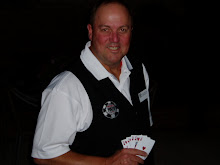As a dealer at the World Series of Poker, I learn new things every day about Poker and how the pros play this wonderful game.
As you might know, the WSOP is truly a "Series" in the sense that more than just the Main Event which makes millions for its final table players, there is an entire series of championship poker tournaments. In 2014 there are 65 championship bracelets to be given to winners of tournaments across a wide spectrum of games.Today I had the pleasure of dealing the Deuce to Seven Single Draw No Limit World Championship Final Table. It had a buy-in of $10,000 and first prize was the world championship bracelet and over a quarter million dollars.When the players arrived to begin the final table of seven, there was quite a lively discussion of the cards being used. Play was going to be streamed live over the Internet and we were set to play it out on the arena stage where, in order to provide the viewing audience with player's hole cards, special cards are used with embedded RFID chips and readers built into the table. The table, however, is really set up for Hold'em, not 5 Card Draw. The RFID cards weren't going to be used to identify cards for this broadcast, but since the automatic shuffler built into the poker table was set up for these larger size cards, the staff assumed it would be fine to just use these cards.Interesting fact: at the World Series of Poker, smaller Bridge size cards are used rather than the larger Poker size cards except at the final table, where this year we are using Poker size cards with jumbo indexes and the embedded RFID chips. Not only are the numbers larger on these cards, but the pips are smaller and framed in the center of the card. The RFID cards are also much thicker and stiffer than the typical cards used throughout the rest of the tournament.Before play began, one of the players, Brian Rast, asked about the cards saying that he didn't think they would work very well. Daniel Negreanu added that you couldn't squeeze them. "Squeezing" in poker parlance is looking at the card by bending the long edge up with thumb over the index and first seeing how many pips are in the row before revealing the value of the card. Both the 4 and 5 have 2 pips across, 6 and 7 have 3 and 8, 9 and 10 have 4. Squeezing adds suspense to looking at your hole cards. When I asked for more detail he explained:"Squeezing is a very important part of this particular game. Let's say I'm drawing one card and I know I need a 4 but a 5 would pair me up and be a very bad card. If I squeeze my card, and I see that it is two across, I know that it's 50-50 that I have the four I need. I can go ahead and bet as if I have it even though there's a 50% chance I'm bluffing. How is my opponent going to be able to tell if I'm bluffing or not when even I don't know if I'm making a value bet or bluffing?"After that passionate explanation, our Floor Supervisor delayed the start of the tournament so that he could replace the RFID cards with standard WSOP cards from the tournament cage. We hand shuffled the decks for the first 2 levels. During the player break the auto-shuffler in the table was replaced to accommodate the standard WSOP deck. Play was pretty normal for a final table after that rocky start.Daniel Negreanu took second place behind the eventual winner, Paul Volpe.
Tuesday, June 10, 2014
Fresh Squeezed Lowball
Subscribe to:
Post Comments (Atom)


2 comments:
Interesting. Never thought about a Blind Bluff. Tim
Good stuff Rookie, lol......Good reading...
Post a Comment